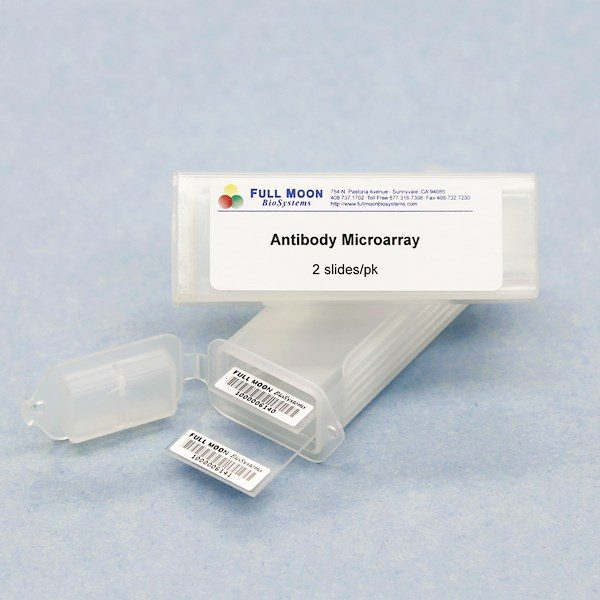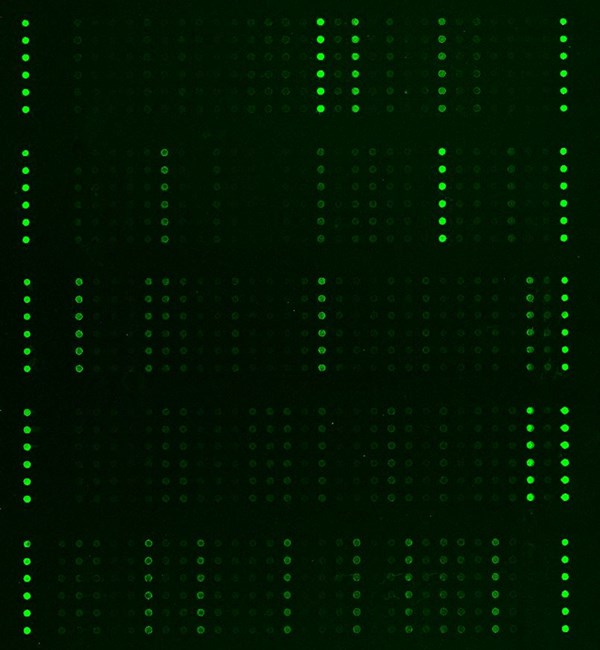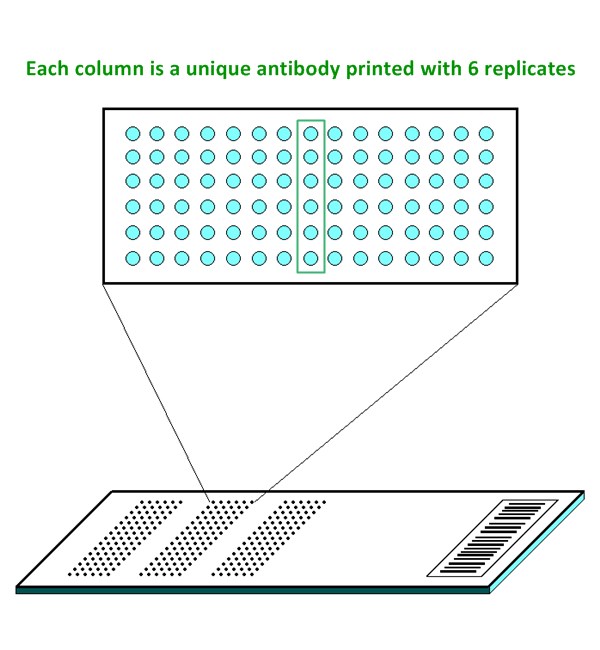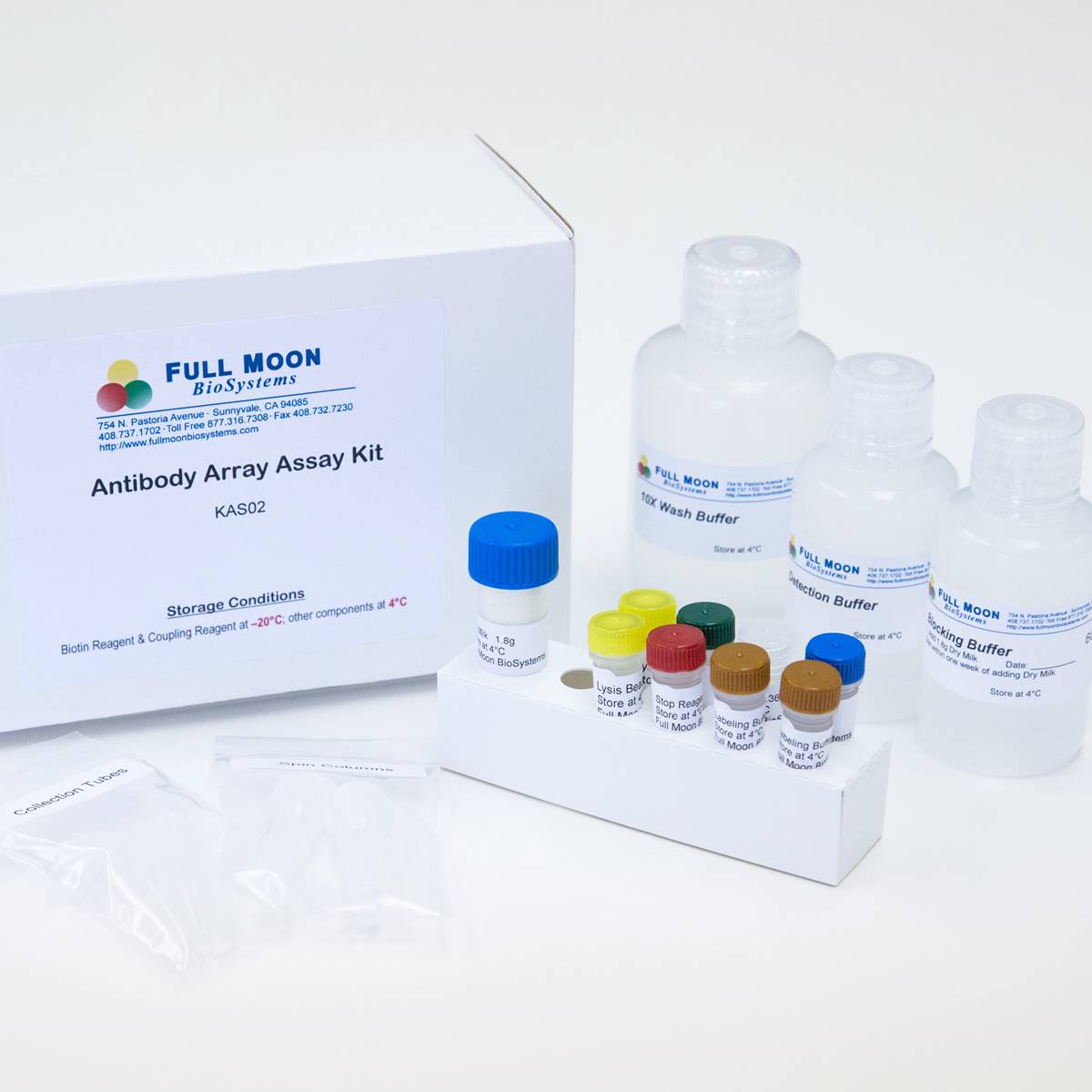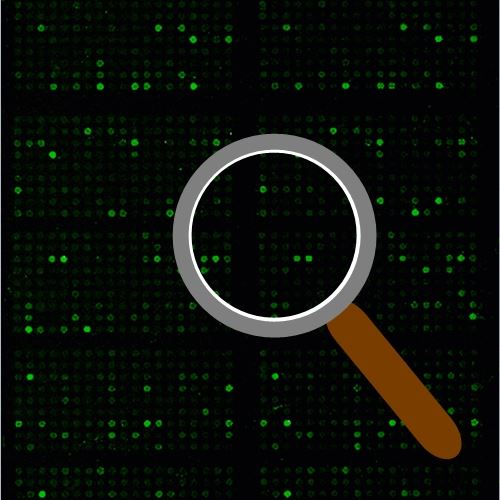Wnt Signaling Phospho Antibody Array
Wnt signaling has a direct association with cancer, type II diabetes, and neurodiseases. Signaling of the highly secreted glycolipoproteins in the Wnt family controls embryonic development and adult homeostasis by regulating β-Catenin’s accumulation in the cytoplasm. When Wnt signaling is absent, β-Catenin is targeted for ubiquitination and degraded by the destruction complex formed by Axin, APC, GSK3, PP2P, and CK-1α. As a result, β-Catenin cannot accumulate in the cytoplasm. When Wnt binds to Frizzled receptors and LRP5/6, Wnt signaling is turned on and disrupts the destruction complex’s function. Now β-Catenin accumulates, moves into the nucleus, and binds to TCF/LEF transcriptor factors to activate gene transcription.
Wnt Signaling Phospho Antibody Array is a high-throughput ELISA based antibody array for qualitative protein phosphorylation profiling. It is suitable for comparing normal samples to treated or diseased samples, and identifying candidate biomarkers. This array features site-specific and phospho-specific antibodies, allowing researchers to study tyrosine and serine/threonine phosphorylation at specific sites.
Key Features
- Site-specific phosphorylation profiling and screening with 227 antibodies
- Antibodies covalently immobilized on 3D polymer coated glass slide
- Fluorescent detection
Specifications
| Product Size: | 2 array slides per package for two samples (untreated vs. treated) |
| Featured Antibodies: | 227 site-specific and phospho-specific antibodies; 6 replicates per antibody |
| Reactivity: | Human: 100% | Mouse: 92% | Rat: 80% |
| Suitable Sample Type: | Cell lysate | Tissue lysate |
| Detection Method: | Fluorescence | Compatible Scanners |
| Internal Controls: | Positive controls: beta-actin | GAPDH | Negative controls |
| Slide dimensions: | 76 x 25 x 1 mm |
| Storage Condition: | 4°C for 6 months |
PRODUCT DETAILS
AKT (Ser124), AKT (Ser246), AKT (Ser473), AKT (Thr308), AKT (Thr450), AKT (Thr72), AKT (Tyr326), AKT (Tyr474), AKT1 S1 (Thr246), AKT1/2/3 (Tyr315/316/312), AKT2 (Ser474), APC (Ser2054), APC1 (Ser355), APC1 (Ser688), CaMK2a (Thr286), CaMK2a/b/d (Thr305), CaMK2b/g/d (Thr287), Catenin a1 (Ser641), Catenin beta (Ser33), Catenin beta (Ser37), Catenin beta (Thr41/Ser45), Catenin beta (Tyr489), Catenin beta (Tyr654), Catenin delta1 (Tyr228), CKI-a (Tyr294), CKI-a (Tyr321), CKI-g 1/2/3 (Tyr263), CKII-a (Tyr255), CKII-b (Ser209), ERK3 (Ser189), ERK8 (Thr175/Tyr177), GPR120, GPR132, GPR150, GPR151, GPR152, GPR153, GPR160, GPR171, GPR173, GPR174, GPR175, GPR18, GSK3a (Ser21), GSK3a/b (Tyr216/279), GSK3b (Ser9), JNK1/2/3 (Thr183/Tyr185), MAP3K1 (Thr1402), MAP3K10, MAP3K11 (Ser674), MAP3K11 (Thr277/Ser281), MAP3K15, MAP3K3, MAP3K4, MAP3K6, MAP3K7 (Ser439), MAP3K71 (Thr187), MAP3K8 (Ser400), MAP3K9, MAP3KL4, MEK1 (Ser217), MEK1 (Ser221), MEK1 (Ser298), MEK1 (Thr286), MEK1 (Thr291), MEK2 (Thr394), MEKKK1, MEKKK4, mTOR (Ser2448), mTOR (Ser2481), mTOR (Thr2446), NFAT1 (Ser326), NFAT3 (Ser168/Ser170), NFAT3 (Ser676), NFAT4 (Ser165), NFAT5 (Ser1197), P38 MAPK (Thr179/Tyr181), P38 MAPK (Thr180), P38 MAPK (Tyr182), P38 MAPK (Tyr322), P44/42 MAPK, PDE4D (Ser190/53), PI3K-p85-a (Tyr607), PI3K-p85-a/g (Tyr467/Tyr199), PKA-a/b CAT (Thr197), PKA-R2-b (Ser113), PKC-a (Thr638), PKC-a (Tyr657), PKC-b (Ser661), PKC delta (Ser645), PKC delta (Thr505), PKC delta (Tyr313), PKC delta (Tyr52), PKC delta (Tyr64), PKC epsilon (Ser729), PKC pan (Thr497), PKC theta (Ser676), PKC theta (Ser695), PKC theta (Thr538), PKC zeta (Thr410), PKC zeta (Thr560), PKG2 (Ser126), PLC beta 3 (Ser1105), PLC beta 3 (Ser537), PLCG1 (Tyr1253), PLCG1 (Tyr771), PLCG1 (Tyr783), PLCG2 (Tyr1217), PLCG2 (Tyr753), PLCG2 (Tyr759), Rac1/cdc42 (Ser71), Rho/Rac GEF2 (Ser885), RhoA (Ser188), SAPK/JNK (Thr183), SAPK/JNK (Tyr185), Src (Ser75), Src (Tyr216), Src (Tyr418), Src (Tyr529), TAK1 (Thr184), Ubiquitin, VE-Cadherin (Tyr731), WNT1, WNT5A
The ELISA based Wnt Signaling Phospho Antibody Array platform involves four major steps:
- Protein extraction with non-denaturing lysis buffer
- Biotinylation of protein samples
- Incubation of labeled samples with antibody array
- Detection by dye conjugated streptavidin
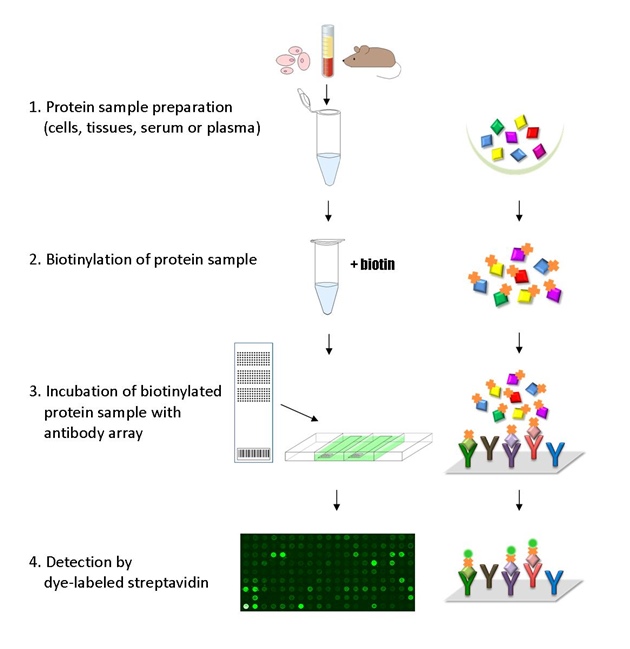
![]() GAL File (To download, right click on the file name, then choose “Save target as”)
GAL File (To download, right click on the file name, then choose “Save target as”)
Chow HM, Sun JK, Low-Density Lipoprotein Receptor-Related Protein 6 Cell Surface Availability Regulates Fuel Metabolism in Astrocytes. Adv. Sci. 2021, 2004993. https://doi.org/10.1002/advs.202004993
de la Encarnación A, Alquéza C, Increased Wnt Signaling and Reduced Viability in a Neuronal Model of Progranulin-Deficient Frontotemporal Lobar Degeneration, Mol Neurobiol, First online: 17 December 2015
Kim, SY, Han YM, DUSP4 regulates neuronal differentiation and calcium homeostasis by modulating ERK1/2 phosphorylation, Stem Cells and Development 2015 Mar 15;24(6):686-700. doi: 10.1089/scd.2014.0434
Kogut MH, Arsenault RJ, A Role for the Non-Canonical Wnt-β-Catenin and TGF-β Signaling Pathways in the Induction of Tolerance during the Establishment of a Salmonella enterica Serovar Enteritidis Persistent Cecal Infection in Chickens, Frontiers in Vet Sci. 2015; 2: 33
Kurzava KL, Ma Y, Epigenetic Effects of Resveratrol on Oncogenic Signaling in Breast Cancer. Nutrients. 2024; 16(5):699. https://doi.org/10.3390/nu16050699
Oldefest M, Düsterhöft S, Secreted Frizzled-related protein 3 (sFRP3)-mediated suppression of Interleukin-6 receptor release by A disintegrin and Metalloprotease 17 (ADAM17) is abrogated in the osteoarthritis-associated rare double variant of sFRP3, Biochemical Journal, 2015 Jun 15;468(3):507-18
Osborn D, Roccasecca R, Loss of FTO Antagonises Wnt Signaling and Leads to Developmental Defects Associated with Ciliopathies, PLoS ONE 2014 Feb 4;9(2):e87662. doi: 10.1371/journal.pone.0087662
Shah R, Spektor T, Reversal of dual epigenetic repression of non-canonical Wnt-5a normalises diabetic corneal epithelial wound healing and stem cells, Diabetologia. 2023 Jul 18. doi: 10.1007/s00125-023-05960-1
Xing M, Li P, Overexpression of p62/IMP2 can Promote Cell Migration in Hepatocellular Carcinoma via Activation of the Wnt/β-Catenin Pathway, Cancers (Basel) 2020, 12(1), 7. doi: 10.3390/cancers12010007
ADDITIONAL SERVICES
If you don’t have access to a microarray, send the finished arrays to our lab for scanning. Raw scan images are delivered in tiff format.
Cost: Free
Array Image Quantification and Analysis Service includes data extraction, data organization and analysis of the array images obtained through our array scanning service.
Cost: $250 per slide
Complete Antibody Array Assay Service allows investigators to send research samples to our laboratory for analysis. There is no need to purchase the arrays and reagents and running the assays yourself. Simply select the array of your choice, and then send off the samples to our lab. This convenient hands-off approach offers quick turnaround and reliable results, saving you valuable time and resources. All assays will be performed by our highly trained scientists at our headquarter in Sunnyvale, California. Results are delivered by email in 1-3 weeks.
Cost: $1,520 per sample

